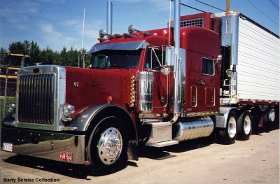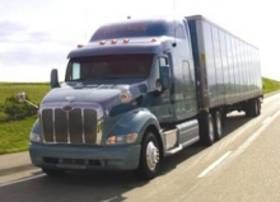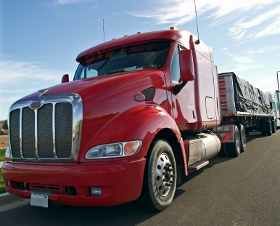Is It Truly Hard To Learn To Drive A Manual Transmission Rig?
Topic 1914 | Page 1

Yes and no. A big rig's manual is different from one in your car or pickup. First, as you ease off the clutch with the transmission in gear the engine will automatically provide the fuel and rpm's to keep the truck running and moving forward. In order to shift you will need to learn to double clutch. search YouTube and you will find some examples. Unlike cars the transmissions are not synchronized so you have to watch your speed and rpms while shifting. I hope this helps. Some instructors will say it is easier to teach someone to shift an 18 wheeler if they have never driven a regular manual transmission.
Double Clutch:
To engage and then disengage the clutch twice for every gear change.
When double clutching you will push in the clutch, take the gearshift out of gear, release the clutch, press the clutch in again, shift the gearshift into the next gear, then release the clutch.
This is done on standard transmissions which do not have synchronizers in them, like those found in almost all Class A trucks.

When I was training they told us "the students with the most manual car transmission experience will have the hardest time". All in all, it's not really all that difficult but certainly not the same. Just go into the training thinking you know nothing about shifting and you'll do better.
I know some drivers will drill me for this but you dont even have to double clutch in those rigs. You can "float" which requires no clutch at all (takes practice) or single clutch if that's comfortable. However, the above techniques will violate warranties on the trucks (there, I'm free from mockery) but your on the road trainer will probably force you to learn how to float along with double clutch. It's safer (dont badger me) to float shift on ice because there's less strain and torque while transitioning between gears.
too much info? you'll be fine, shifting is easy in time. We all screwed up at some point and lost a gear or slowed too much on a hill. Personally, day one i couldn't recover from losing a gear while downshifting up Donner Pass on the I80. I just pulled over and started over, no big deal.
As far as failing CDL test... I stalled 3 times and thought i failed. Turns out, all i needed was to not stall in an intersection for an instant fail. Hopefully that makes you feel better.
CDL:
Commercial Driver's License (CDL)
A CDL is required to drive any of the following vehicles:
- Any combination of vehicles with a gross combined weight rating (GCWR) of 26,001 or more pounds, providing the gross vehicle weight rating (GVWR) of the vehicle being towed is in excess of 10,000 pounds.
- Any single vehicle with a GVWR of 26,001 or more pounds, or any such vehicle towing another not in excess of 10,000 pounds.
- Any vehicle, regardless of size, designed to transport 16 or more persons, including the driver.
- Any vehicle required by federal regulations to be placarded while transporting hazardous materials.
Double Clutch:
To engage and then disengage the clutch twice for every gear change.
When double clutching you will push in the clutch, take the gearshift out of gear, release the clutch, press the clutch in again, shift the gearshift into the next gear, then release the clutch.
This is done on standard transmissions which do not have synchronizers in them, like those found in almost all Class A trucks.
HOS:
Hours Of Service
HOS refers to the logbook hours of service regulations.I know some drivers will drill me for this but you dont even have to double clutch in those rigs. You can "float" which requires no clutch at all
Nobody here is gonna drill ya for it - we know. In fact it seems almost a little odd to teach double clutching but I guess it's safer to know it than to not.
Ron, the guys are right - it's different in a rig than in a 4 wheeler but not so much that you should be concerned with it. You'll pick it up just fine like everyone else. We're all a little hesitant to go into too many details describing how to shift or anything because we'll probably confuse the situation more than we'll help it. But suffice to say you shouldn't be concerned about it. You'll pick it up just fine.
Here's a pretty good video about shifting and double-clutching. Notice how every time he shifts he pumps the clutch twice but only a very short distance. You only push in the clutch on a big rig maybe 2 inches to get it to disengage.
How To Shift And Double Clutch A Tractor Trailer
This video shows the proper technique for shifting and double clutching a tractor trailerDouble Clutch:
To engage and then disengage the clutch twice for every gear change.
When double clutching you will push in the clutch, take the gearshift out of gear, release the clutch, press the clutch in again, shift the gearshift into the next gear, then release the clutch.
This is done on standard transmissions which do not have synchronizers in them, like those found in almost all Class A trucks.
Double Clutching:
To engage and then disengage the clutch twice for every gear change.
When double clutching you will push in the clutch, take the gearshift out of gear, release the clutch, press the clutch in again, shift the gearshift into the next gear, then release the clutch.
This is done on standard transmissions which do not have synchronizers in them, like those found in almost all Class A trucks.
TWIC:
Transportation Worker Identification Credential
Truck drivers who regularly pick up from or deliver to the shipping ports will often be required to carry a TWIC card.
Your TWIC is a tamper-resistant biometric card which acts as both your identification in secure areas, as well as an indicator of you having passed the necessary security clearance. TWIC cards are valid for five years. The issuance of TWIC cards is overseen by the Transportation Security Administration and the Department of Homeland Security.
HOS:
Hours Of Service
HOS refers to the logbook hours of service regulations.
You know, I wish I had a solid answer on the synchronized and non-synchronized transmissions. I trained on non-synchronized trucks in trucking school and had a real hard time. I was used to synchronized in my cars and light truck. I've heard some people say all big trucks are non-synchronized while others say they are synchronized with some still being non-synchronized. I had a bad time of it as all my instincts were wrong for big trucks; especially downshifting. I think if ever actually do any trucking, I'm the type who will get a automatic transmission and skip the whole dilemma. So if there is a manufacturer who sells synchronized trucks, I'd love to know who they are. Note: I dropped out of trucking school due to family problems so I'm far from anyone to really listen to.

Ronald, you will be fine brother, I remember when I had to take my CDL test, I was up all night going thru the entire thing, I also remember telling myself a few month from now I will remember this and say I over worried about it, and that same thing came to past, I am now solo for last 3 month so don't worried and don't over think it, study yes, be focus yes, but in 3 month or so you will be telling yourself the same thing,....out
HI I have had tons of manual hot rod cars growing up and manual trucks but also know there is no comparison to a four or five speed car or truck to a ten speed or more big rig. I read sort of scary stories of being on a hill with a vehicle right behind you and stalling and failing yor cdl test. I went thru that learning a stick auto but seems more to it in a big rig. Any thoughts on it would be appreciated. thank you Ron
CDL:
Commercial Driver's License (CDL)
A CDL is required to drive any of the following vehicles:
- Any combination of vehicles with a gross combined weight rating (GCWR) of 26,001 or more pounds, providing the gross vehicle weight rating (GVWR) of the vehicle being towed is in excess of 10,000 pounds.
- Any single vehicle with a GVWR of 26,001 or more pounds, or any such vehicle towing another not in excess of 10,000 pounds.
- Any vehicle, regardless of size, designed to transport 16 or more persons, including the driver.
- Any vehicle required by federal regulations to be placarded while transporting hazardous materials.
OWI:
Operating While Intoxicated
I think if ever actually do any trucking, I'm the type who will get a automatic transmission and skip the whole dilemma
I totally agree with everyone above - it's not that big of a deal. Everyone fumbles and flounders with it for a while and then you get it down. Once you get it you can't remember what you thought was so hard about it before. You definitely don't want to test out on an automatic transmission and get that restriction on your license. Train and test in a standard so you have the full range of options when it comes time to find a job. If you'd rather drive an automatic there's nothing wrong with that. In fact, almost everyone prefers them once they've tried them. But make sure you train and test on a standard.
I never drove stick... am a 43 yr old woman from NJ who never lived around farm equipment. I never drove with any sort of boat or camper trailer.
Driving stuck takes practice. By my second day on the road my trainer had me driving 400 miles a day. That got upped to 550 once I got my license. It can be very frustrating... and for me it 2as worse having someone watch me all the time. My first week on my own I shifted soooo much better than I did with a trainer.

You wont be tested with a loaded trailer so stalling will only happen if you dont start out in low low on a hill.
You wont be tested with a loaded trailer so stalling will only happen if you dont start out in low low on a hill.
Negative on that. Rookies can find all kinds 9f ways to screw up. I got to the first intersection of my test and popped the clutch too quickly... impeded traffic automatic fail. 2nd time I got 90 percent through and was in 6th taking a left turn ... someone came flying around a corner and I slowed down without shifting. When I fueled it to go.... stalled. Automatic fail. 3rd time was a charm for me.
New Reply:
New! Check out our help videos for a better understanding of our forum features

















Preview:








 TT On Facebook
TT On Facebook
HI I have had tons of manual hot rod cars growing up and manual trucks but also know there is no comparison to a four or five speed car or truck to a ten speed or more big rig. I read sort of scary stories of being on a hill with a vehicle right behind you and stalling and failing yor cdl test. I went thru that learning a stick auto but seems more to it in a big rig. Any thoughts on it would be appreciated. thank you Ron
CDL:
Commercial Driver's License (CDL)
A CDL is required to drive any of the following vehicles:
OWI:
Operating While Intoxicated